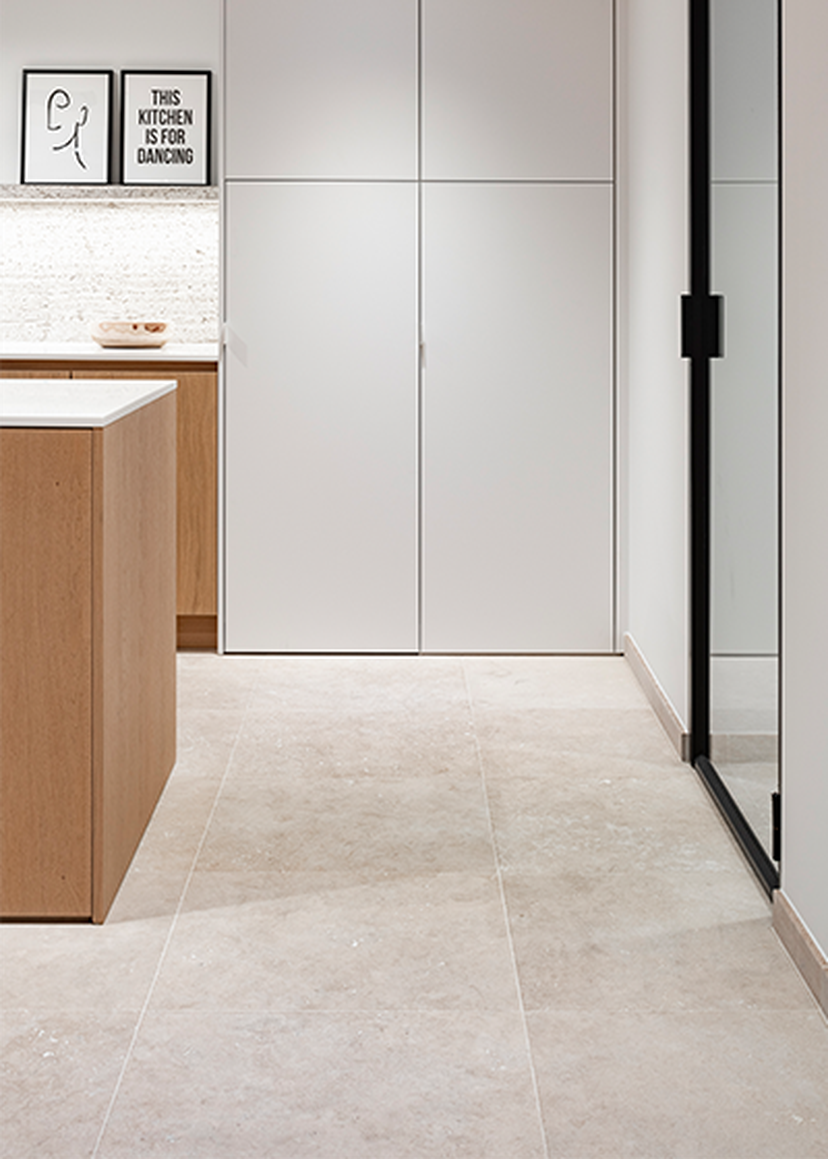The warm, natural appearance of travertine
Travertine is primarily composed of lime. Yet this limestone has a different appearance to 'traditional' limestones. This is due to the process involved in its creation.
Creation
Limestone is formed geologically in seas and oceans. In contrast, travertine originates on the mainland, close to hot springs and waterfalls. The hot water from the springs dissolves a portion of the lime. Once the water cools, at the site of a waterfall for example, some of that dissolved lime is deposited against pre-existing layers of limestone. Twigs, leaves and other organic matter also find their way to the bottom of the springs and waterfalls, where they settle amongst the layers of lime. This organic matter decomposes over time, leaving pits and holes in the limestone and creating the characteristically porous texture of travertine.
Similar to the growth rings in trees, the changing seasons create distinctive layers or bands - an interplay between dark and light, narrow and wider zones. The colour variation in travertine is determined by its mineral content. Travertine is most commonly found in hues of beige or cream, but also comes in shades of copper red, blue-grey and brown.
Explore our travertine range
The distinctive appearance of travertine
The texture and appearance of travertine is partly determined by the way in which the blocks are cut. Blocks can be cut in two ways:

Travertino Romano Striato Vein Cut - Honed
"Vein Cut": The block is cut so that the bands or veins are exposed. As a result, the characteristic linear texture is visible on the surface of the slabs.

Travertino Romano Striato Cross Cut - Sabbiatino
"Cross Cut": The block is cut perpendicular to the linear texture, creating a more cloudy design on the surface of the slabs.
Both cutting methods accentuate travertine's characteristically porous texture. These pores can be left “unfilled” or filled using mastic or cement during production or installation. Both the type and colour of the filler can vary, affecting the appearance of the stone.
Travertine is easy to work with. We regularly apply innovative new finishes in addition to our more conventional polished and honed ones.
Travertine in the spotlight: Pietra Bicci



Pietra Bicci is a beautiful Italian natural stone, renowned for its durable nature and timeless appearance. Its warm, earthy tones add a touch of elegance and serenity to every space. Cloudy travertine differs from other travertines in that it contains fewer holes. Pietra Bicci is therefore considerably more compact. It also boasts reduced porosity, making it easy to polish. The distinctive qualities of Pietra Bicci make it a versatile choice for both classic and contemporary interiors, creating perfect harmony between practicality and aesthetics.
Travertin applications
Travertine is suitable for both interior and exterior use, and for a variety of applications.
Interior use
Travertine is a popular choice for floor tiles or wall coverings in kitchens, living rooms and bathrooms. We strongly recommend opting for filled travertine in your interiors. This facilitates the maintenance of travertine floors and prevents water from seeping into the holes in wet areas and damaging your travertine. The latest trend, however, is to use unfilled travertine in the home. In that case, the pores must be filled with grout during installation.
Exterior use
Only unfilled travertine is suitable for outdoor application. This is because the filler in filled travertine cannot withstand freezing temperatures. The filler can come lose from the stone in sub-zero weather. Most types of travertine are suitable for use as cladding or exterior flooring, but unfilled. Despite its high porosity, travertine is one of the more durable limestones. This makes it suitable for use in technically challenging installation techniques, such as anchored cladding and tile support systems.

In the spotlight: high-end allure with the warmth of travertine
The refurbishment of the HasHotel in Hasselt comprised both a renovation and expansion. A section of the hotel was demolished and replaced with a new structure of neatly arranged prefabricated floors. This poised, elegant and dynamic design with sophisticated details was created by Hasselt-based agency UAU Collectiv. And despite an exceptionally exquisite façade featuring strips of vitrified brick, it’s the natural stone that steals the show. From the moment you enter HasHotel, there’s simply no escaping the travertine.

In the spotlight: dynamic travertine façade
Baelskaai forms part of Ostend’s new Oosteroever district. This comprehensive development reconciles new and existing architecture with the port and its surroundings. The green interior enhances the project’s liveability and dynamism. A sleek, symmetrical façade with enclosed terraces was constructed for one of the modern apartment buildings using 2,500 square metres of natural stone tiles.

Travertine maintenance
The same maintenance and installation guidelines apply to travertine as for limestone and marble. Acidic products are obviously not recommended. We advise facilitating indoor maintenance by impregnating the surface, particularly in stain- and moisture-prone areas. Use a detergent that’s suitable for natural stone for everyday maintenance, and occasionally apply a protective care agent for added stain resistance.
Always consult the supplier's technical information sheet to familiarise yourself with the various applications, installation method and maintenance requirements of your favourite travertine.






















